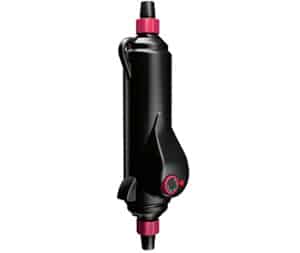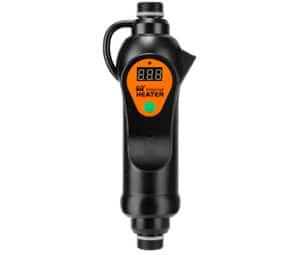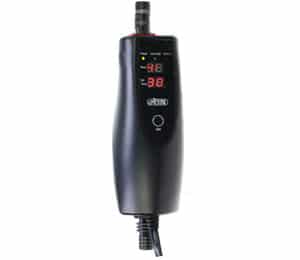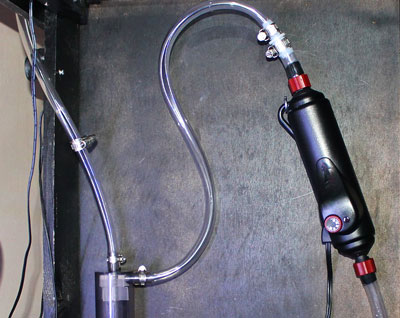Having the best inline heater for aquarium means you can provide your fish with a constantly heated and comfortable environment. Although you don’t usually need a heater for freshwater fish, it is required if you have a saltwater aquarium. This is especially true if you live in an area that gets quite cold.
The decorative saltwater fish live in tropical waters, so they will need their water to be somewhat warm. The closer the water conditions are in the tank to their natural environment, the healthier and happier your fish will be.
Having a heater is quite important if you want your fish to breed and lay eggs. They will be unable to do so when the temperature is even a tad too cold.
This article, National Park Aquarium will be teaching you how to choose the right inline heater for your tank. You no longer need to worry about wasting your money on something that will not work at all.
Best Inline Heater for Aquarium Reviews
1. Hydor In-Line Heaters

Aside from a tube cutter, you do not need any other tools to install the Hydor inline heater in your aquarium. The only thing you should do is to cut the return tube in the middle and then install this heater in the middle of the hose. The heater comes with clamps on both ends that will hold the tubes securely.
You do not have to fiddle with buttons when using this heater. If you are not quite technically inclined, you will be glad that it only has a rotary dial that you use to adjust the temperature settings. You will know if the heater is working when the red indicator light turns on. It will continuously heat the water as long as you plug it in.
What I liked about in-line external heaters like this is that they do not clutter the inside of the tank. If you have a large tank, you will need several heaters to keep the water temperature stable.
In addition, because this device has such a slim profile, it is easy to conceal. I keep mine at the back of my aquarium cabinet, so it is neatly hidden and still easy to access when needed.
This product is also quite affordable. If you have a rather limited budget for aquarium accessories, or you cannot afford to invest in the fancier ones on the market, this is a valid alternative.
Some might say that you will be getting what you paid for. However, as long as you know what to expect and are aware of how to fix simple issues, this will work just fine.
Now, speaking of issues, I have a major one with the input and output hose connectors. I would have loved to just use the built-in hose clamps but they are seriously lacking, especially if you will be using a sump pump or a cartridge filter.
If the water pressure is even just remotely strong, water would leak from the connectors. If it does, it will short-circuit the heater.
- Easy to install and set up
- Easy to use – It just has one dial to turn
- Does not clutter the inside of the tank
- Constant heat
- Affordable
- The connectors tend to leak easily
- Does not have short circuit protection
If you have a limited budget for tank accessories, you might like this product. However, since the built-in hose clamps are not that great, they tend to leak and cause the heater to short circuit. I managed to find a workaround using hose connectors but you do not have to do this if the connectors were any good.
2. DaToo External in-Line Aquarium Heaters

Unlike other inline heaters that I have used so far, this one has replaceable inlet and outlet hose connectors. This is great because it means you can use this with any brand or kind of filter system that you have. Also, the built-in hose clamps hold the hoses tightly and create a good seal. I have yet to spot a leak in the heater since I started using it.
There is no danger of this heater shorting out and killing your precious fish. Although it looks simple, it also comes with several fail safes. One of which is a short circuit protection system.
It automatically cuts off the power to the heating elements once it detects a short circuit. This also comes with an automatic cut-off switch that turns the device off if the temperature goes above the set limit.
I also liked that the heating element of this in-line heater comes encased in German-made shatterproof glass. I’ve already gone through a couple of in-line heaters that conked out because their glass cases cracked from the heat.
This device’s heating element case allows heat to radiate outward but is also quite durable that it can withstand sudden temperature shocks without cracking.
I may not have been using the in-line heater that long (around 6 months now) but I have seen heaters that broke a lot sooner than this. Some of the cheaper heaters I have tried gave up after just 2 months or so.
They showed signs of giving up right after just the first month. According to other customer reviews, though, it seems like this can last at least 2 years of constant use.
While I appreciate this gadget, I’ve noticed a quirk with its temperature regulation. Every time I adjust the temperature, it seems the real temperature is a tad higher by a degree or two than what’s shown on its display. It’s a minor hiccup, really. The temperature remains largely stable nonetheless.
- The kit comes with several hose adapters
- Features a heating element encased in shatterproof glass
- Comes with an overheat protection system
- Very durable – It can last for years without skipping a beat
- Easy to install and control
- The thermometer is a bit inaccurate
- The heat fluctuates a bit throughout the day but not by much
Although the inaccuracy of the thermostat is a bit of a letdown, it is at least quite consistent with heating. Just set the temperature a degree or two below your target and it will work just fine. I have been using mine for close to six months and it is still working as advertised.
3. ISTA in-Line External Heaters

One of the complaints that many people have about most in-line water heaters is that they burn out fast. This is true for some cheaper brands but this product has a built-in overheat cut-off switch.
Even if you let it run dry for a bit, the protection system will kick in and turn off the device before it can seriously damage itself. This also means that it will turn off automatically once the water in the tank reaches its desired level.
Also, unlike other in-line heaters, this comes with a temperature display. This means you do not necessarily need a separate, in-tank thermometer to monitor the temperature in the tank.
Now, I am a bit paranoid with my aquarium, so I still use a separate thermometer, and it was a bit surprising to see that both thermometer readings are almost always the same.
This device is also really easy to operate. It just has a single button that lets you set the temperature of the device. There is no need to navigate different menus and settings. Just set the temperature and you can forget about it. This is also quite a durable little heater. I have been using mine for almost a year and it is still working like new.
If you are thinking of getting this device, go for one that fits your canister filter perfectly. This device comes in different options depending on the size of the filter canister you have.
With that, it is easier to choose because you need to pick the heater based on the size of your tank and canister filter. The good thing about this is that you only need to choose the one that fits your filter.
Speaking of the fit of the hoses, it seems a bit off in this regard. I got the 5/8-inch diameter option but for some reason, the hose coming from the cartridge filter was loose.
It was so loose that even after I fully plugged the hose into the heater, I could still twist it easily. Thankfully I did not use the filter immediately; otherwise, it will surely leak. I had to use metal hose clamps to provide a good seal but I had to be careful not to crack the plastic.
- Comes with overheat protection – It also has an automatic cut-off feature
- Includes a built-in temperature display – The temperature reading is highly accurate
- One-button operation
- Can fit into most canister filter systems
- Durable and made to last
- The hose connectors are either too loose or too tight
- Only displays temperature in degrees Celsius
Despite the hose-fitting issues, this in-line water heater has so far been among the best that I have used. This heats the water at just the right rate. It is quite accurate when measuring the actual water temperature. Although the installation was a bit of a hassle, once you get it up and running, you will no longer need to worry about anything else.
What to Look for When Buying a Inline Heater for Aquarium

There are so many in-line heater choices out in the market but you can only consider a handful as worth your money. To help you choose the right product, here are a couple of factors you should consider.
1. Temperature Accuracy
This is one of the most important details that you need to look for when you are shopping for a water heater. The heater should be able to get the water to the same temperature that you set it to, or at least close to it.
It is almost impossible to find a heater that can get the temperature setting exactly right. Still, ensure that the temperature difference should not be more than one or two degrees Celsius.
You might not find any honest admissions to the manufacturers’ claims of accuracy, but there should be plenty of user reviews online that you can use as references. For instance, the Fluval inline heater has plenty of reviews saying that it is quite precise at heating the water.
2. The Fit
The way an in-line water heater works is that you install it in the middle of the return hose of your canister filter. The water will heat up as it passes through the heater before going back into the tank.
Now, this means that you will need to find a heater with connectors that fit snugly into the hoses of your filter. For instance, a larger canister filter will have a larger hose. For that, an inline aquarium heater 500w should be big enough.
Some heaters claim that you can just insert the tube into the connector and everything will be fine. I found those claims to be wrong most of the time. Make sure that the heater you buy comes with a hose clamp or a tightening nut that will create a good seal around the hose.
You do not want any water to leak from the hoses and douse the circuitry of a heater because it will short-circuit immediately. However, just to be sure, you should buy some hose clamps to prevent the hoses from leaking.
3. Consistency
I have used quite a couple of in-line heaters through the years, and some of them have trouble keeping a consistent temperature in my tank. There have been some devices that maintain the same temperature for a couple of hours.
However, after that, the temperature would suddenly spike tremendously for an hour or so at different parts of the day. This is why you should consider the volume of the water in your tank when buying a heater.
For instance, if you need an inline heater for a 125-gallon aquarium, check the specs of the products if they can maintain constant heat for that size of tank. If you want to prevent this from happening, choose a heater with an automatic cut-off switch.
This should kill the heater when the water reaches the desired temperature. It will also somewhat ensure that the water remains at the same temperature throughout.
4. Protection Features
When you are buying a heater, pick one that has complete protection features. For instance, to prevent the water from getting too hot, you need a heater equipped with overheat protection. This allows the heater to cut off once it reaches the set temperature and would turn back on again when the water gets cold.
Another nice safety feature to have is short circuit protection. If ever the hoses spring a leak, the water will not damage the heater because the short circuit protection would cut off the power immediately.
5. Ease of Use
The heater should be easy to use. Most of the heaters available nowadays come with one-button operation. This means that you only need to push one button to turn on the heater and set the temperature.
Conclusion
You may not need it when you have a freshwater tank. However, if you have a marine aquarium, you bet you will need the best inline aquarium heater. Be careful, though, because a lot of the heaters in the market these days do not last very long.
Some products can even present fire hazards, a risk no aquarium owner would want to take. With these considerations in mind, it’s clear that you need to be well-informed and careful when shopping for water heaters for your aquarium.
List of review
- The Best 10 Gallon Fish Tank Heater: 2023 Reviewed & Buyer’s Guide
- The Best Aquarium Heater for 75 Gallon Tank in 2023




